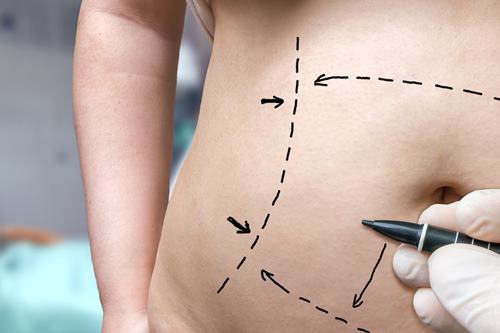Gastric Sleeve (Sleeve Gastrectomy)
Everything You Need to Know About Gastric Sleeve Surgery
Are you tired of feeling self-conscious about your stomach? Have you struggled with your weight for years and non-surgical methods just haven’t cut it? Well, gastric sleeve surgery might be the key to unlocking your lighter, healthier self.
But before you dive into the operating room, let’s discuss everything you need to know about gastric sleeve surgery!
What is a Gastric Sleeve?
Gastric sleeve surgery, also known as sleeve gastrectomy, is a surgery performed for weight loss. It removes 75-80% of the stomach, which leaves it as a long and narrow banana-shaped tube which leads to holding less food and decreases the ghrelin hormone production, which makes you feel less hungry. Gastric sleeve surgery is a minimally invasive surgery that is typically performed laparoscopically. This means that the surgeon makes several small incisions in your abdomen and inserts a laparoscope (a thin, tube-like camera) and surgical instruments, then uses the laparoscope to remove the larger part of your stomach, leaving behind the sleeve-shaped stomach.
Why Should You Have Weight Loss Surgery?
Gastric sleeve surgery is a major one. Think of it as a last resort, not a quick fix. However, if you’re morbidly obese (BMI over 40) or have serious weight-related health issues like type 2 diabetes, sleep apnea, or high blood pressure, it could be a life-changer. Studies show that gastric sleeve surgery can lead to dramatic weight loss (up to 60-70%!), and it can also significantly improve or even reverse those pesky co-morbidities.
Why Choose to Have a Gastric Sleeve?
Gastric sleeve surgery is the ideal option for bariatric procedures. It’s not too complex like a bypass, not too restrictive like a band. It’s minimally invasive (think laparoscopic!), has fewer long-term complications, and boasts a higher rate of resolving obesity-related conditions compared to banding. You won’t also have to deal with foreign objects hanging around your body, just a sleek new stomach that helps you eat smarter.
Who is Best Suited to a Gastric Sleeve?
Only a qualified doctor can determine whether you’re a perfect fit for the gastric sleeve or not. However, if you struggle with these issues, you are most likely a good candidate for gastric sleeve surgery:
Seriously overweight (BMI ≥ 40) or have a BMI of 35-39.9 with obesity-related health problems like diabetes or sleep apnea
Motivated and committed to making healthy changes
Ready to embrace a new, healthier you
But remember, surgery is a serious decision. It’s crucial to weigh the pros and cons carefully with your doctor.
Indications for Gastric Sleeve Surgery
Some general indications for gastric sleeve surgery are:
A body mass index (BMI) of 40 or higher: BMI is a measure of weight with height. A BMI of 40 or higher is considered severely obese and is associated with several serious health risks, such as heart disease, stroke, type 2 diabetes, and sleep apnea.
A BMI of 35 to 39.9 with at least one weight-related health condition: These conditions may include type 2 diabetes, high blood pressure, high cholesterol, sleep apnea, severe acid reflux, or joint problems.
A BMI of 30 to 34.9 with uncontrolled or poorly controlled type 2 diabetes: This means that you are unable to control your blood sugar levels with diet, exercise, and medication.
In addition to these general indications, there are other individual factors that your doctor will consider such as your age, overall health, medical history, lifestyle and habits, and psychological readiness for surgery.
Deciding on a gastric sleeve is a big step, so understanding the pros and cons is crucial. Here’s a breakdown to help you weigh the advantages and disadvantages:
Advantages of Gastric Sleeve Surgery
Significant weight loss: Studies show an average weight loss of 60-70%, potentially leading to improved health and well-being.
Reduced hunger: The sleeve removes hunger hormone-producing cells, curbing cravings and helping you eat less.
Improved health: Gastric sleeve surgery can significantly improve or even reverse obesity-related conditions like type 2 diabetes, high blood pressure, sleep apnea, and joint problems.
Minimally invasive: Laparoscopic surgery means smaller incisions, faster recovery, and less pain compared to other weight-loss procedures.
No foreign implants: Unlike gastric bypass, the sleeve doesn’t involve placing any objects inside your body, minimizing the risk of long-term complications.
Lower follow-up visits: Compared to banding and bypass, the sleeve generally requires fewer follow-up appointments with your doctor.
Potential for fertility improvement: For some people, especially those with Polycystic Ovary Syndrome, weight loss through the sleeve can improve fertility.
Disadvantages of Gastric Sleeve Surgery
Irreversible: Unlike banding, the sleeve is a permanent change to your stomach.
Early complication risk: The sleeve has a slightly higher risk of early complications like leaks and infections compared to banding.
Heartburn risk: Some people experience heartburn after the surgery, although this can often be managed with medication.
Lower diabetes remission rate than bypass: While the sleeve can significantly improve diabetes, it may not lead to complete remission as often as gastric bypass.
Dietary restrictions: You’ll need to follow a strict post-operative diet to ensure proper healing and avoid complications.
Psychological commitment: Long-term success requires a commitment to healthy habits and lifestyle changes.
Potential for nutrient deficiencies: Vitamin and mineral deficiencies can occur, requiring lifelong supplementation.
Cost: Gastric sleeve surgery can be expensive, and insurance coverage may vary.
Risks and Complications of Gastric Sleeve Surgery
The gastric sleeve procedure is not all sunshine and rainbows, it’s still a surgery, and just like any surgery it comes with risks and potential complications. Some of these include leaks, infections, and heartburn. Although they’re rare, they still can happen. And unlike bypass, the gastric sleeve doesn’t guarantee complete diabetes remission.
Gastric Sleeve Procedure
Gastric sleeve surgery is typically performed laparoscopically. In simple terms, here is a step-by-step overview of the procedure:
The patient is placed under general anesthesia.
The surgeon makes several small incisions in the abdomen.
The surgeon inserts the laparoscope and surgical instruments through the incisions.
The surgeon divides the stomach vertically using a stapling device.
The surgeon removes the larger, curved part of the stomach.
The surgeon closes the incisions with sutures.
Don’t worry, it’s not that complicated in real life. It usually takes one to two hours to complete, and you’ll most likely be able to leave in a day or two!
Post-operative Care for Gastric Sleeve
The first few weeks are all about gentle sips and rest, like a spa day for your tummy. Your new sleeve needs a little TLC, so liquids and clear fluids become your best friends. You’ll most likely experience some pain, fatigue, nausea, and vomiting. Then you’ll gradually be able to eat more solid foods and your energy levels will rise. You’ll be taking some prescribed supplements to ensure that you’re getting all the important nutrients. After six weeks, you can welcome your new lifestyle. You’ll be fully recovered, and throughout the whole process, you’ll need to go to all of your follow-up appointments and listen to your doctor’s instructions.
FAQs About the Gastric Sleeve Procedure at Aesthetic Airways
How long will the effects of gastric sleeve surgery last?
The effects of gastric sleeve surgery are long-term effects that could last for years. However, it’s important to note that it’s possible to regain weight, that’s why you must make important diet and lifestyle changes to maintain your dream body.
How much weight can I expect to lose after gastric sleeve surgery?
Weight loss after gastric sleeve surgery is most rapid in the first few months. You’re expected to lose 50-70% of your excess weight within the first year. After that, the weight loss rate will slow down gradually. However, it’s important that every individual has a unique body and responds to the surgery differently.
Will I need to make dietary and lifestyle changes after gastric sleeve surgery?
Yes. Dietary and lifestyle changes are essential to maintain your weight and improve your overall health. After the surgery, your stomach will be much smaller than it was. This means that you’ll need to eat smaller portions of meals more frequently. You’ll also need to avoid foods that are high in sugar and fat. In addition, you’ll need to quit bad habits such as smoking, taking needed supplements, and exercising regularly.
How long does it last? Can the gastric sleeve procedure be undone?
This process brings about a permanent modification to the stomach that cannot be undone. However, the part of the stomach that is removed does not affect the overall function of the stomach. Digestion and absorption of nutrients are not changed with the gastric sleeve procedure.
Gastric Sleeve Weight Loss Surgery Before & After
Are you considering or preparing for a gastric sleeve surgery with Aesthetic Airways? If so, explore our gallery of previous patients to see the team’s work.








